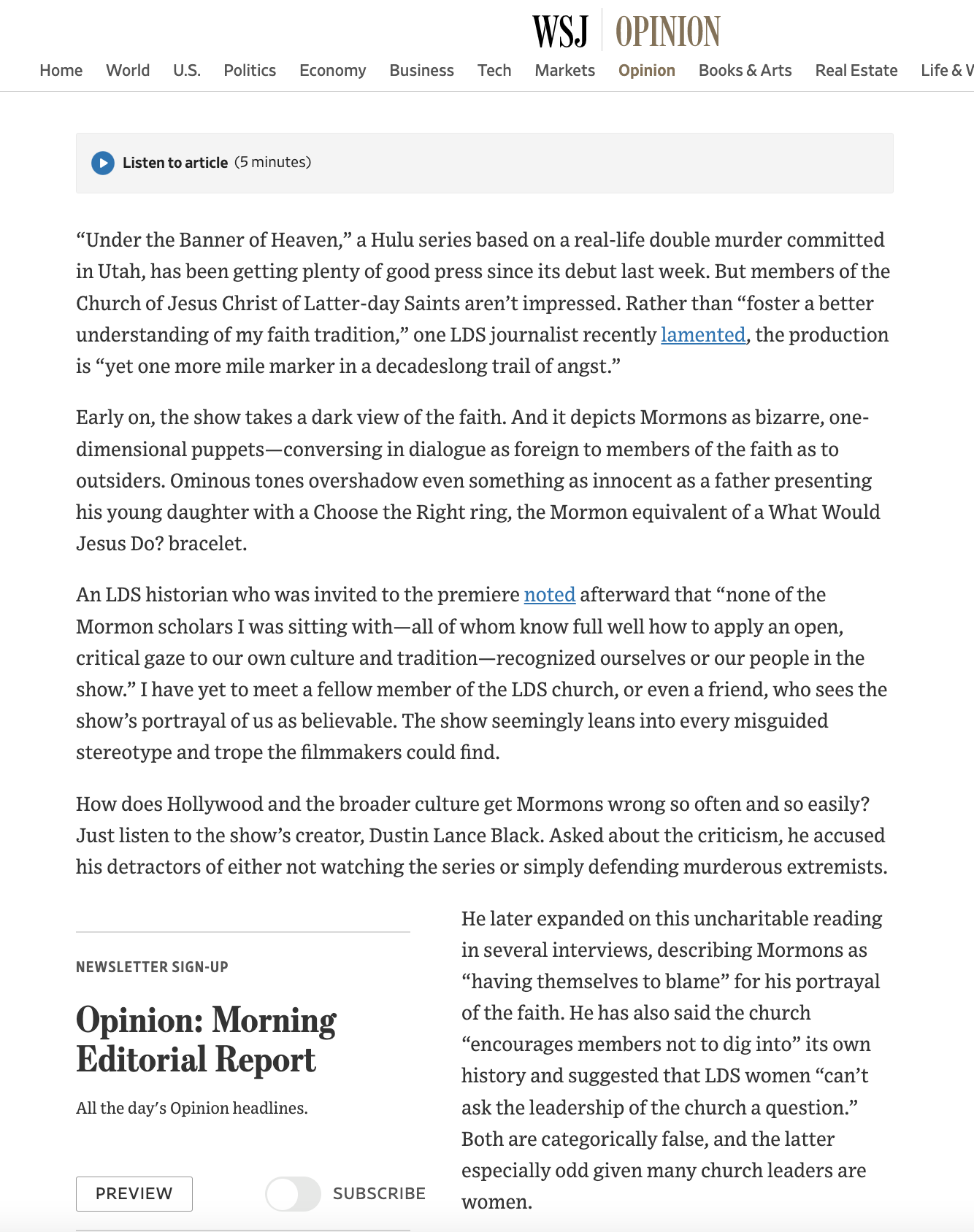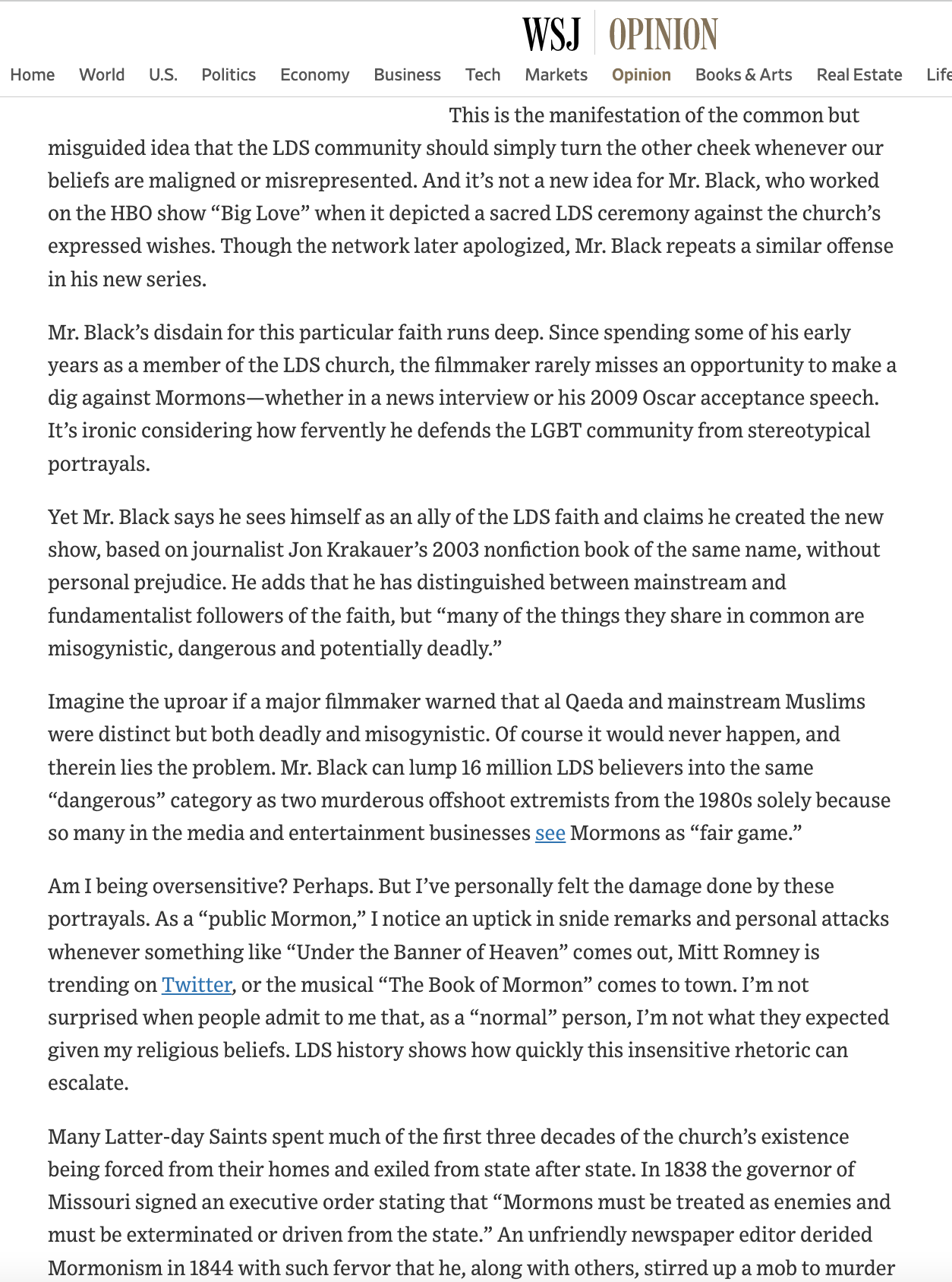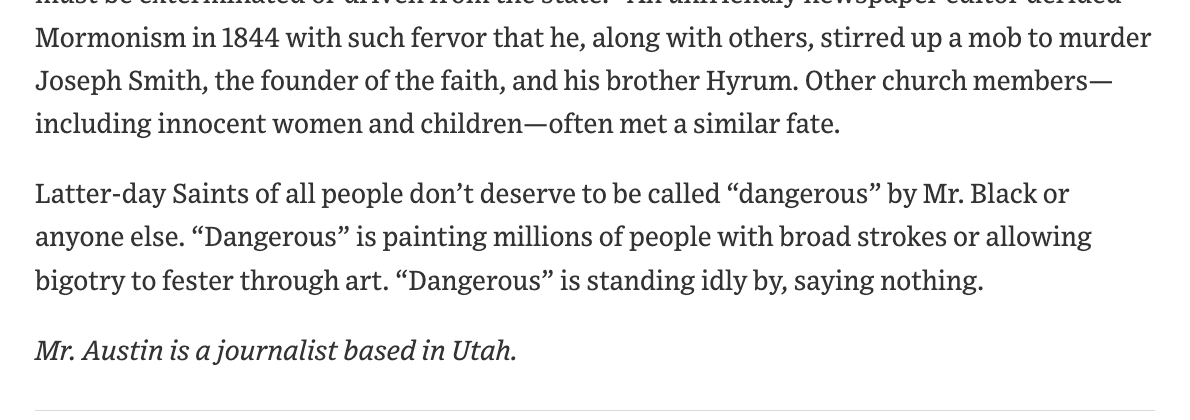Daryl Austin describes how the miniseries depicts Latter-day Saint poorly.
- Type
- News (traditional)
- Source
- Daryl Austin LDS
- Hearsay
- Journalism
- Reference
Daryl Austin, "About Those 'Dangerous Mormons,'" The Wall Street Journal, May 5, 2022, accessed May 20, 2022
- Scribe/Publisher
- The Wall Street Journal
- Audience
- Internet Public
- Transcription
“Under the Banner of Heaven,” a Hulu series based on a real-life double murder committed in Utah, has been getting plenty of good press since its debut last week. But members of the Church of Jesus Christ of Latter-day Saints aren’t impressed. Rather than “foster a better understanding of my faith tradition,” one LDS journalist recently lamented, the production is “yet one more mile marker in a decades long trail of angst.”
Early on, the show takes a dark view of the faith. And it depicts Mormons as bizarre, one-dimensional puppets—conversing in dialogue as foreign to members of the faith as to outsiders. Ominous tones overshadow even something as innocent as a father presenting his young daughter with a Choose the Right ring, the Mormon equivalent of a What Would Jesus Do? bracelet.
An LDS historian who was invited to the premiere noted afterward that “none of the Mormon scholars I was sitting with—all of whom know full well how to apply an open, critical gaze to our own culture and tradition—recognized ourselves or our people in the show.” I have yet to meet a fellow member of the LDS church, or even a friend, who sees the show’s portrayal of us as believable. The show seemingly leans into every misguided stereotype and trope the filmmakers could find.
How does Hollywood and the broader culture get Mormons wrong so often and so easily? Just listen to the show’s creator, Dustin Lance Black. Asked about the criticism, he accused his detractors of either not watching the series or simply defending murderous extremists.
He later expanded on this uncharitable reading in several interviews, describing Mormons as “having themselves to blame” for his portrayal of the faith. He has also said the church “encourages members not to dig into” its own history and suggested that LDS women “can’t ask the leadership of the church a question.” Both are categorically false, and the latter especially odd given many church leaders are women.
This is the manifestation of the common but misguided idea that the LDS community should simply turn the other cheek whenever our beliefs are maligned or misrepresented. And it’s not a new idea for Mr. Black, who worked on the HBO show “Big Love” when it depicted a sacred LDS ceremony against the church’s expressed wishes. Though the network later apologized, Mr. Black repeats a similar offense in his new series.
Mr. Black’s disdain for this particular faith runs deep. Since spending some of his early years as a member of the LDS church, the filmmaker rarely misses an opportunity to make a dig against Mormons—whether in a news interview or his 2009 Oscar acceptance speech. It’s ironic considering how fervently he defends the LGBT community from stereotypical portrayals.
Yet Mr. Black says he sees himself as an ally of the LDS faith and claims he created the new show, based on journalist Jon Krakauer’s 2003 nonfiction book of the same name, without personal prejudice. He adds that he has distinguished between mainstream and fundamentalist followers of the faith, but “many of the things they share in common are misogynistic, dangerous and potentially deadly.”
Imagine the uproar if a major filmmaker warned that al Qaeda and mainstream Muslims were distinct but both deadly and misogynistic. Of course it would never happen, and therein lies the problem. Mr. Black can lump 16 million LDS believers into the same “dangerous” category as two murderous offshoot extremists from the 1980s solely because so many in the media and entertainment businesses see Mormons as “fair game.”
Am I being oversensitive? Perhaps. But I’ve personally felt the damage done by these portrayals. As a “public Mormon,” I notice an uptick in snide remarks and personal attacks whenever something like “Under the Banner of Heaven” comes out, Mitt Romney is trending on Twitter, or the musical “The Book of Mormon” comes to town. I’m not surprised when people admit to me that, as a “normal” person, I’m not what they expected given my religious beliefs. LDS history shows how quickly this insensitive rhetoric can escalate.
Many Latter-day Saints spent much of the first three decades of the church’s existence being forced from their homes and exiled from state after state. In 1838 the governor of Missouri signed an executive order stating that “Mormons must be treated as enemies and must be exterminated or driven from the state.” An unfriendly newspaper editor derided Mormonism in 1844 with such fervor that he, along with others, stirred up a mob to murder Joseph Smith, the founder of the faith, and his brother Hyrum. Other church members—including innocent women and children—often met a similar fate.
Latter-day Saints of all people don’t deserve to be called “dangerous” by Mr. Black or anyone else. “Dangerous” is painting millions of people with broad strokes or allowing bigotry to fester through art. “Dangerous” is standing idly by, saying nothing.
Mr. Austin is a journalist based in Utah.
- Citations in Mormonr Qnas
The B. H. Roberts Foundation is not owned by, operated by, or affiliated with the Church of Jesus Christ of Latter-day Saints.



